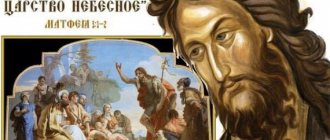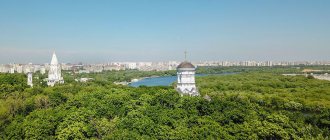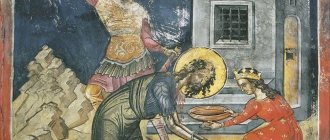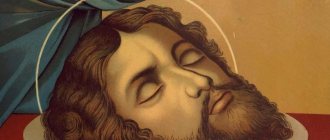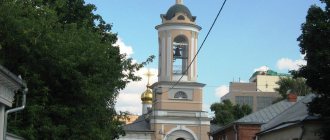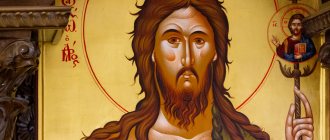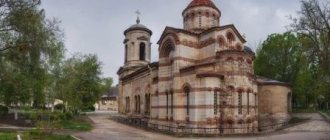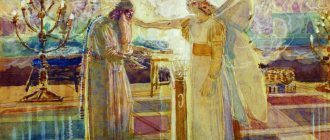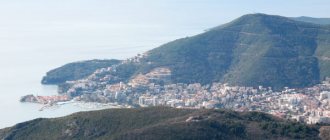Beheading of St. John the Baptist: icons, frescoes, paintings
The beheading of John the Baptist;
16th century, Greece. Athos, Dionysiates Monastery The martyrdom of the greatest of the saints - John the Baptist - is one of the most interesting subjects in icon painting. Sometimes the image is extremely laconic: only a humbly bowed prophet and an executioner-seculator with a raised sword. Sometimes the composition becomes complex: Salome sets up a dish into which the severed head should fall, Herod sits on the throne, the disciples bury the body of the Forerunner.
With the Beheading of St. John the Baptist is symbolically connected by two more iconographic subjects. On the icons of Christ's Descent into Hell, St. John, the “seal of the prophets,” is depicted as announcing to the Old Testament righteous the coming of the Savior and imminent deliverance from hellish darkness and the shadow of death. This is the church tradition: after his death, the prophet preached in hell. It is no coincidence that in the holiday troparion it is sung “thou didst preach the good news to those in hell, who was revealed in the flesh.”
John the Baptist answers questions
Another image is the so-called “John the Baptist Angel of the Desert.” It was especially common in Russia in the 16th and 17th centuries, and subsequently among the Old Believers. This image is symbolic - the features of St. were strengthened in it. John as a hermit and preacher of repentance, and therefore a forerunner of monasticism. On his charter it is usually written “Behold the Lamb, take away the sins of the world” or “Repent, for the Kingdom of Heaven is drawing near.” It has two large wings, which symbolically mean fasting and prayer, raising to God. He has a dish in his hand. It is correct to write in it the image of the infant Christ (the sacrificial Lamb), who was preached by the “voice crying in the wilderness,” but often icon painters place in it the severed head of the saint himself.
N. E. Makovsky, “View of the church of the village of Dyakova in Kolomenskoye near Moscow” (1872), fragment. Perhaps the most famous surviving temple in Russia, consecrated in honor of the Beheading of John the Baptist. Today is the patronal holiday here
In these two heads on one icon, one can already feel the slight influence of the Western tradition of depicting saints with the attributes of their martyrdom, which will subsequently lead to the emergence of a new type of icon - a naturalistic depiction of the head of St. John the Baptist on a platter (sometimes with his eyes closed, i.e. dead) or even one chapter.
St. John the Baptist. Encaustic icon of the 6th century from the collection of the Museum of Art. Bogdan and Varvara Khanenko in Kyiv (Formerly the Museum of Western and Eastern Art). This icon was in the monastery of St. Catherine in Sinai, from where Archimandrite was taken. Porfiry (Uspensky) in 1850
Often in the fresco painting system the life cycle of John the Baptist, incl. and the scenes of the Beheading and Finding of the Head could be located in the deacon. Finding the head of John the Baptist. Fresco of the deacon of the Cathedral of the Nativity of the Virgin Mary at the Anthony Monastery in Novgorod. 1125 (left). Beheading of John the Baptist Fresco of the deacon of the Church of the Annunciation on Myachina (“in Arkazhi”) near Novgorod. 1189 (on right)
St. John the Baptist. Fresco of the church of the Gracanica monastery (Serbia, Kosovo), 14th century
Scenes from the life of St. John the Baptist. 1. Baptism. John the Baptist before Herod. 2. John the Baptist in prison. Truncating a chapter. 3. Herod's Feast. Burial of John the Baptist. These six images on three boards were most likely cut out from the icon of John the Baptist in the Life. Byzantium, turn of the XIV-XV centuries, from the collection of the State. Historical Museum
Beheading of John the Baptist, bringing the head to Herod, Burial of John the Baptist. Mosaics of the Baptistery of St. Mark's Basilica in Venice, mid-14th century
John the Baptist Angel of the Desert. Icon from the so-called series "tablets" of Sofia Novgorodskaya. Late 15th – early 16th century. Now - in the State Assembly. Russian Museum
The beheading of John the Baptist. Icon of the 16th century from the collection of the Museum of Russian Art in Kyiv
St. John the Baptist with scenes from his life. Icon of the mid-16th century from the Church of St. Nicholas Nadein in Yaroslavl. Images of such iconography became widespread in Rus' at that time, including because John the Baptist was the namesake saint of Tsar Ivan the Terrible
John the Baptist - Angel of the Desert. Icon of the 60s. 16th century from the Stefano-Makhrishchi Monastery (now in the collection of the Andrei Rublev Museum)
The beheading of John the Baptist. Russian North, 17th century (in the collection of the Arkhangelsk Regional Museum of Fine Arts)
The beheading of John the Baptist. Greek master, 17-18 centuries. From the collection of the State. Historical Museum
Beheading of John the Baptist, 17th century. Icon of the Stroganov School from the collection of the Museum of Icons in Recklinghausen (Germany)
St. John the Baptist with scenes from his life. In the top row are the twelve feasts - Epiphany, Resurrection and Entry of the Lord into Jerusalem. On the left is the Nativity of the Forerunner and the Finding of the Head, on the right is the Beheading of the Head and its bringing to Herod’s feast. Palekh, first half of the 19th century, private collection in Germany
Holy head of John the Baptist. Russian icon of the late 19th century
St. John the Baptist with scenes from his life. Master Semyon Ivanov, 1840. From the collection of the Museum. Andrey Rublev
The beheading of John the Baptist. Pskov icon of the late 16th century
The beheading of John the Baptist. Fresco of the Church of the Assumption of the Gracanica Monastery (Serbia, Kosovo). Around 1321, the Beheading of John the Baptist; 16th century, Greece. Athos, Dionysiat Monastery
John the Baptist with scenes from his life: the Gospel of Zechariah (Luke 1:5-22), the Baptism of the Lord, the Nativity of John the Baptist, the Beheading of the Prophet; Byzantium 13th century; Sinai, monastery of St. Catherine
The beheading of John the Baptist; Russia, 16th century
The beheading of John the Baptist; Mosaic of the Florentine Baptistery with scenes from the life of the Prophet, fragment, 1250 - 1330.
The beheading of John the Baptist; Russia, 18th century
The beheading of John the Baptist; 19th century, Russia, workshop of the Novotikhvinsky Monastery, Yekaterinburg; Ekaterinburg Museum of Fine Arts
The beheading of John the Baptist, fresco; Balkans, 17th century
"Dance of Salome" by Benozzo Gozzoli, 1472
“John the Baptist before Herod” Mattia Preti, 1665
"Salome Dancing Before King Herod" by Gustav Moreau, 1876
“Beheading of John the Baptist” by Vasily Khudyakov, 1861
“The Beheading of John the Baptist” by Jacopo da Ponte Bassano, v.p. 16th century
"Chapter of John the Baptist" by Carel Fabricius, 1640
“Beheading of John the Baptist” by Puvis de Chavannes, 1869
"The Revenge of Herodias" by Juan Flandes, 1496
“Beheading of John the Baptist” by Caravaggio, 1608
"Salome" by Lucas Cranach the Elder, 1530
“Salome receives the head of John the Baptist” by Andrea Solario, pp. 16th century
St. John the Baptist, modern icon
Today, in memory of the martyrdom of John the Baptist, is a day of strict fasting in the Orthodox tradition.
The history of the holiday
This holiday appeared a very long time ago and not even here, but only in Egypt and Alexandria in the fourth century. Around 414 and 415, Augustine preached a sermon on John and his life at Ippo. After this, the holiday began to spread and after some time came to us.
Pagan roots of the holiday
But, as you know, in Orthodoxy many holidays were associated with paganism. This led to the fact that the name of the holiday is Christian, but the traditions and customs remain from another faith.
So, for us, even before the establishment of Christianity in Rus', it was a holiday of the transition from summer to autumn. Naturally, everyone was preparing for this season, storing food for the winter. This holiday was also special for our ancestors because the harvest was ending. And this event was special for the Slavs and, of course, where without pagan rites and rituals. However, we will tell you about this in the next category.
First finding of the head
During the reign of the ruler Constantine the Great, two Orthodox monks twice dreamed of the image of St. John the Baptist, who indicated the area where his head was located. Having found this relic, the monks put it in a bag made of camel hair and headed to their home. On the way they meet a stranger who was carrying a bag.
The holy prophet appeared to a stranger in a dream and ordered him to run away from the monks with his head in a vessel.
The stranger kept this vessel in his family for a long time, but later the priest Eustathius took possession of it. Having learned about the miracles that the head could perform, he decided to use it. They soon learned of his blasphemy; the priest hid his head, hoping to regain possession of it. But the Lord did not allow this to happen. And inside the cave, which was located not far from Emessa, at the location of the relic, a new monastery was built.
